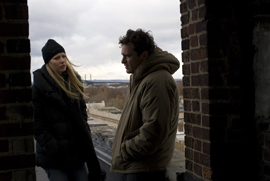
By Elise Nakhnikian
From the needle-thin metal fingers that rip apart a rag doll and sew it back together over the opening credits to the flying Scottie dogs that zoom over the audience during the ones at the end, the 3-D version of Coraline makes us all Alices in a stop-motion wonderland.
Based on an award-winning children’s book by Neil Gaiman, Coraline spins a fanciful story on classic fairy tale foundation: Coraline is a resourceful little girl who has to rely on courage, wit, and a little help from her friends to defeat a dangerous witch, who disguises herself at first as an ally. A door in Coraline’s house that usually opens onto a brick wall sometimes becomes the portal to a magical parallel world. And Coraline keeps going repeating her journey, but her reasons for going and her actions once there change as she figures out what’s going on under the surface.
Coraline and her parents (she’s an only child) have just moved halfway across the country, to a rambling old house in Oregon. Her parents are preoccupied with work, leaving Coraline to her own devices. She drops in on the eccentric neighbors, explores the surrounding woods, and befriends a shy neighbor boy, Wybie (Robert Bailey Jr.), and the semi-feral black cat (voiced by Keith David) who shadows them both. And she goes through that door in the wall, of course, where she finds a world that’s almost exactly like her own, only better. Or is it?
The house Coraline finds on the other side of the door is better decorated, brighter, and cosier than her real home. Even the parents she finds there seem better at first. Her “other mother” is all cooing attention and perfectly roasted chicken. Her other dad is suave where her real dad is embarrassingly geeky, crooning away like Bing Crosby. Even the stuff there is cooler: her toys talk and move, and some of the furniture is alive.
Coraline’s world pulls us in because, surreal as it is, it always feels real enough to touch. The 3-D helps, since it’s used not so much to shock and awe as to place you right into the middle of the set. Director Harry Selick specializes in moody, emotionally complex animated fairy tales (he also directed The Nightmare Before Christmas and James and the Giant Peach), and he makes Coraline’s worlds – particularly the one she enters through the door in her wall -- feel more vivid than our own. You can practically feel the damp chill of the big empty rooms in Coraline’s house, the spongy floor of the tunnel she crawls through to the other world, and the warmth of the other mother’s kitchen.
Selick recorded his Coraline script before shooting the movie, capturing vocal performance by an excellent cast that includes Dakota Fanning as Coraline and John Hodgman and Teri Hatcher as her parents. The handmade sets and puppets were then filmed to match the dialogue, creating what its press release calls “the biggest animated feature production ever to be made in stop-motion animation, and the first to be made in stereoscopic 3-D.” It’s amazing to see how much feeling and life this laborious process generates.
Coraline is a pistol. Brave and funny, curious and ingenious, capable and vivacious, she’s one of the most memorable heroines to appear in a year that was studded with great female movie roles. Wybie is charming too, with his kind heart and nervous motor mouth.
There are also a lot of nice moments where the filmmakers remind us about things like how suddenly lighthearted play can turn scary in childhood, the instant friendships that can form, the almost brutal honesty that’s part of daily conversation between friends, and the things kids notice that grownups look right through.
The faces are amazingly expressive, too – so mobile you almost forget that they’re not real people. The filmmakers created thousands of subtle variations by using so-called replacement animation, making computer models based on drawings created by a 2-D animator. These were then printed out on 3-D printers, hand-painted, and placed on the puppets.
But using puppets in place of actors lets the filmmakers exaggerate body language enough to make it comical – while keeping it accurate enough to be eloquent. Coraline’s affable but ineffectual father, for instance, is so used to hunching over his laptop that his neck extends like a giraffe’s, and Coraline sometimes flings her body around in an exaggerated version of that thing kids do when they’re bored. And every time I see my cat cock her head to look at something, I think about the cat in Coraline, whose head sometimes tilts so far to one side you half expect him to tip over.
The animation also lends itself to equisitively atmospheric creepiness. When Coraline catches on to the witch's game and the witch lets her true self emege, it's like a children's nightmare come to life as she morphs from a prettier, cuddlier version of Coraline’s mother to a skeletal monster, more spider than witch.
Moments like that may be too scary for very little kids, but the preteen Coraline fans sitting behind me last weekend approved of this movie, and it definitely delighted this particular post-teen.



